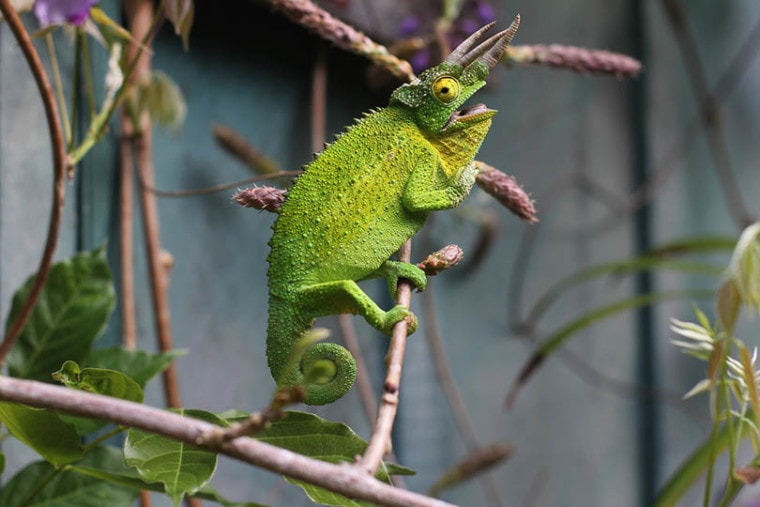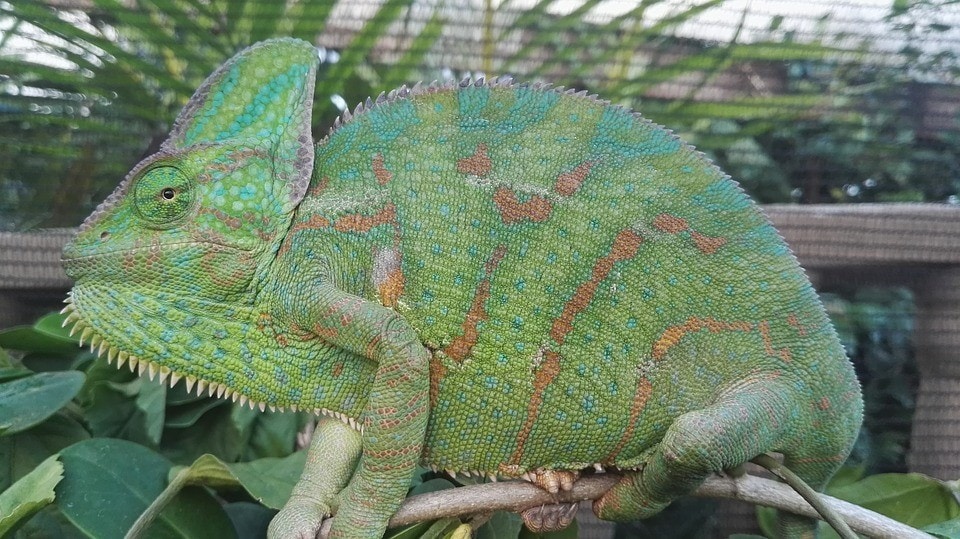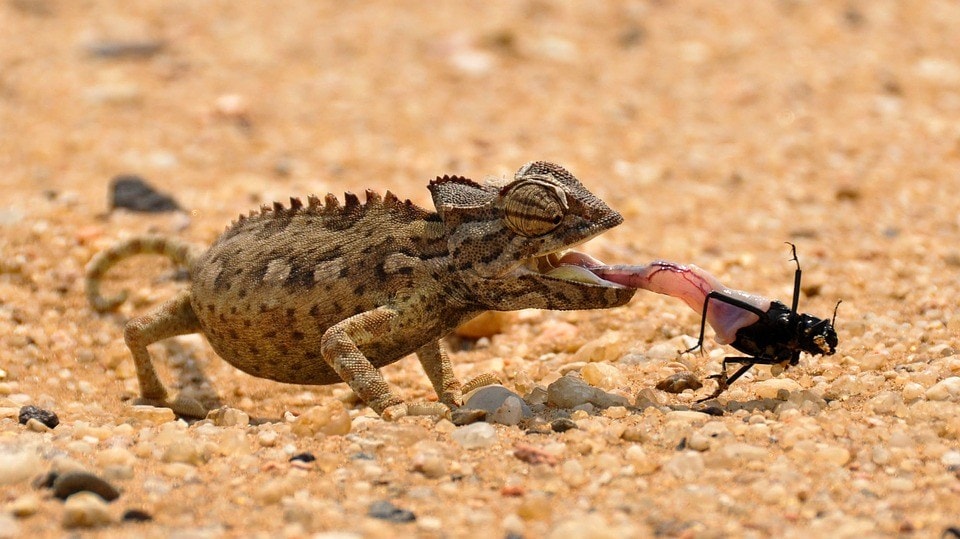
Do you love the slow-paced, quirky-eyed, ever-changing look of the chameleon? These exciting creatures have quite a fascinating appeal. If you aren’t familiar with owning a chameleon, you might be wondering if they would make a good pet for you.
Chameleons can make excellent pets in the right circumstances, but they aren’t the best choice for everyone. That’s because chameleons require an exact care regimen with a more hands-off approach. That might be attractive to some potential owners and not so much for others. Here are some things you should know about owning a chameleon before you fully commit.
Quick Facts About Chameleons
| Scientific Name: | Chamaeleonidae |
| Family: | Chamaeleonidae Rafinesque |
| Natural Habitat: | Rainforests, tropical climates |
| Temperature: | 70-80 degrees Fahrenheit |
| Temperament: | Shy, slow, solitary |
| Type: | Arboreal |
| Colors: | Brown, green, red, blue, orange, yellow |
| Length: | 12-20 inches |
| Weight: | 0.4-7 ounces |
| Lifespan: | 2-10 years |
| Experience Level: | Intermediate |
Chameleons, scientifically called Chamaeleonidae, hail from hot climates from rainforests to deserts. They typically live in tropical climates of Africa, South Europe, Asia, Madagascar, and Hawaii.
Chameleons are famous for being able to blend into their environment by morphing the color of their skin. There are several different species—some with brilliant color-changing capabilities and others who have more subtle shades.
Most chameleons are relaxed, shy creatures who really like to be alone. Being as isolated as they are, you won’t have to worry about buying a companion, but you will have to respect their boundaries.
If the idea of showing off your chameleon excites you, you might want to take note of their personality. Sure, it’s really wonderful to show friends just what your reptile is capable of, but it can also be very stressful for them.
Plus, you’ll have to uphold your end of the bargain—sometimes providing expensive food and care. So, what are all the ins and outs you should know?
The 9 Things to Know Before Getting a Chameleon
1. Chameleons Aren’t Cuddly
If you wanted a chameleon that will hang out on your shirt all day, that isn’t going to happen. Chameleons don’t enjoy being handled. If you hold them too much, it can even have a negative impact on their health.
Chameleons can get very sick or irritated by certain perfumes or laundry detergents, so be careful when you touch them with your hands or stick them onto your clothes. Any movements should happen slowly, so you don’t startle them.
If you do opt for a chameleon, expect to look but not touch. You won’t want to make it ill with stress, since that can cause a serious health decline. Some lizards can be exceptionally social, like bearded dragons or geckos. But chameleons prefer the quiet quarters of their cage instead.

2. Chameleons Come in Many Varieties
You won’t have a lack of choices when you pick out your chameleon. They have so many intriguing patterns.
When you go to pick out your chameleon, keep these things in mind:
Chameleons will vary in appearance and size depending on the type. Some are more vibrant, while others are less flashy. Some are also much easier to care for, while others can create huge responsibilities.
Be sure to research your specific type of chameleon when you’re looking to buy. That way, you can create a suitable environment for them.
3. Chameleons Need Big Enclosures
Chameleons are generally small lizards, only reaching about 18 to 24 inches, tail included. Females tend to be in the 10 to 13-inch range. Since they live in trees in the wild, they will need a tall cage and plenty of foliage to climb around in.
These lizards require a cage that is at least 4’ L x 4’ H. They will spend most of their time leisurely climbing up the branches, snoozing as they bask. Height is more important than the width of the cage, but you shouldn’t substitute any space.

4. Chameleons Require Specific Conditions
Chameleons are native to tropical climates where the weather is hot and humid. They need humidity set for at least 65% to 80%. They are comfortable in temperatures between 70 and 90 degrees Fahrenheit. You can buy gauges to monitor temperature and humidity levels in the enclosure.
You have to offer water often. They gather most of their hydration by licking droplets from leaves in their cage. You can buy misting systems that go off automatically every few hours, keeping the plants watered and giving moisture to your chameleon.
5. Chameleons Have Strict Diets
You can’t just feed a chameleon anything—they have pretty strict requirements. Chameleons are considered insectivores, meaning they eat mainly insects. Adults should eat one big meal every other day.
When you go to pick out your chameleon, keep these things in mind:
Chameleons have lightning-fast tongues, so prepare for quick grabs. Their tongues can be twice the length of their whole body! It’s best to use tongs if you plan to hand-feed your chameleon.
Calcium is also a highly necessary mineral in their diet. You’ll need to purchase calcium powder to offer them. Most owners dip gut-loaded insects into the powder to take care of nutritional needs in one swoop.
You have to be very careful when you offer calcium powder with added vitamin D3. While this vitamin is essential, they gather most of it through UV light exposure. Too much intake can cause serious complications.
Alternatively, not having enough vitamin D3 can create unhealthy bone structure and poor skin health. Make sure lighting, temperature, humidity, and diet correlate with one another.

6. Chameleons Can Be Very Sensitive
If you’re a first-time reptile owner, chameleons can be a challenging pick. They require extremely specific environmental conditions, become sick easily, and don’t handle external stressors very well. If you don’t know exactly how to manage their care, it could lead to some pretty severe consequences.
Chameleons can have issues with many chemicals and toxins that you might not realize. You should never use any household cleaners or aerosol sprays around their enclosures. These things can make your chameleon very sick—even killing them if they’re exposed to too much at once.
7. Chameleons Are Arboreal Creatures
You might never see your chameleon at the bottom of their cage—unless something is medically wrong with them. Chameleons love trees, spending most of their time clinging to branches. You have to accommodate their needs by providing (preferably) live plants in their enclosure.
When you go to pick out your chameleon, keep these things in mind:
Plants and trees add life to your enclosure. Not only are they crucial for the wellbeing of your reptile—they also provide clean air and aesthetic appeal. Since the cage takes up such a large space, it’s an extra perk to make it look natural and eye-catching.

8. Not All Chameleons Change Color
It’s widespread knowledge that chameleons can change color to blend with their environment. However, not all chameleons change color drastically. Some can switch between vibrant hues of pinks, blues, and oranges. Others stay between shades of brown or green.
Chameleons have guanine crystals in their skin cells. Chameleons can shift the space between crystals, which changes the light reflection from the skin. Females are typically less color-changing than their male counterparts.
9. Chameleons Need Vet Care, Too
Don’t mistake it—reptiles need vet care, too. It might be a bit trickier finding an exotic vet who has chameleon medical experience. But before you purchase your chameleon, you’ll want to check out local exotic vets so you can plan for routine care.
Regular veterinarians that take care of more common pets like dogs and cats might not have the experience to provide reptile exams. But many vets can refer you to a local place that can. Don’t be afraid to call around to check your options.
It would be best if you got your chameleon to the vet of your choice every 6 to 12 months for necessary checkups. Of course, your chameleon could have minor or major health issues that require more frequent trips. Having a fund set aside for possible emergencies is a smart move—just in case. Exotic vets tend to be a bit pricier than traditional offices.

Choosing a Chameleon
When you go to pick out your chameleon, keep these things in mind:
1. Consider Care Requirements
be ready with your recently learned chameleon knowledge so you can give your reptile 100% adequate care. Know each part of routine maintenance, potential sensitivities, and overall health needs. The more you research, the better capable you’ll be.
2. Choose Physical Appearance
the intriguing look of a chameleon is probably what attracted you to the idea in the first place. Choose a chameleon that melds with the image you have in your head—but don’t buy solely on this factor.
3. Provide an Appropriate Setup
Plants, plants, and more plants are necessary for your chameleon. So, not only are you caring for a sometimes challenging reptile, but you’ll also have to create a natural environment with healthy, lush plants and proper moisture.
4. Select Healthy Specimens
when you buy a chameleon from a breeder, make sure they have a stunning reputation for producing healthy offspring. Try to steer clear of pet stores since they often don’t get the appropriate care early on. It can cause shorter lifespans and more health issues down the line.
5. Prepare for the Unknown
any type of pet care can be costly, so expect the unexpected. Make sure you have an exotic vet in line so you can take your chameleon for routine checkups or for emergency visits.

Is a Chameleon Right for You?
Chameleon care can be a lot to take on if you aren’t prepared for the task. Learning as much as possible about these creatures will ensure you can give them the life they deserve. These remarkable reptiles are gorgeous, fascinating animals that need constant maintenance.
If you’re looking for an easygoing reptile that doesn’t mind frequent handling, you might want to search for other cold-blooded cuties. These guys don’t enjoy contact and prefer to look pretty on a branch instead.
- Next on your reading list: Do Chameleons Bite Humans? Are They Dangerous?
Featured Image Credit: StockSnap, Pixabay









